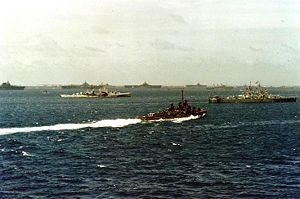- USS Shannon (DM-25)
-

Steams past task forces gathering for the Okinawa Operation, circa March 1945. Location is probably Ulithi Atoll.Career 
Builder: Bath Iron Works Laid down: 14 February 1944 Launched: 24 June 1944 Commissioned: 8 September 1944 Decommissioned: 24 October 1955 Struck: 1 November 1970 Fate: sold for scrap, May 1973 General characteristics Class and type: Robert H. Smith-class destroyer Displacement: 2,200 tons Length: 376 ft 6 in (114.76 m) Beam: 40 ft 10 in (12.45 m) Draft: 18 ft 10 in (5.74 m) Speed: 34 kts Complement: 363 officers and enlisted Armament: 6 5”, 12 40mm., 8 20mm., 2 depth charge tracks, 4 depth charge projectors USS Shannon (DD-737/DM-25/MMD-25) was a Robert H. Smith-class destroyer minelayer in the United States Navy. She was named for Marine Colonel Harold D. Shannon.
Shannon (DD-737) was laid down on 14 February 1944 by the Bath Iron Works, Bath, Maine; launched on 24 June 1944; sponsored by Mrs. Harold D. Shannon; reclassified DM-25 on 19 July 1944; and commissioned on 8 September 1944, Commander E. L. Foster in command.
Contents
Transfer to Pacific
Completing shakedown in the Bermuda area in late October, Shannon was ordered to overtake convoy GUS-54 and deliver election ballots before proceeding to Norfolk, Virginia for availability. She accomplished her mission; completed the yard work; and, on 21 November, sailed for the Pacific. On the 25th, she rescued two crewmen from a downed USS Tuscaloosa (CA-37) scout plane. She arrived in the Panama Canal Zone on the 27th.
From there, she continued on to California and Hawaii. On 27 January, Shannon, flagship of Mine Division (MinDiv) 7 and a unit of Task Force 51, departed Pearl Harbor for Eniwetok, Saipan, and Iwo Jima. At the latter island, on 19 February, she conducted antisubmarine patrols as marines landed; then, during the afternoon, she moved in to provide fire support. For the next five days, she rotated between those duties; then returned to Saipan to escort reinforcement and resupply echelons to the embattled island.
She returned to Iwo Jima on 3 March and resumed duty-night illumination, harassing fire, and call fire- in support of the 4th Marine Division for another five days. On the 8th, she sailed for Ulithi; and, on the 19th, she left the Western Carolines for the Ryukyu Islands and Operation Iceberg, the invasion of Okinawa.
Okinawa
Shannon arrived off Kerama Retto, an island group west of Okinawa, on 25 March and covered minesweeping units and underwater demolition teams until that base was secured. She then protected the minesweepers as they prepared the way for the landings on Okinawa. On 1 April, when the troops were landed on the Hagushi beaches, she patrolled to the east of Kerama Retto; then moved to the southern coast of Okinawa to screen the demonstration landings there. Further screening duties followed; and, on the 4th, she retired to the rear area. On the 15th, she returned to Okinawa and resumed screening duties. On the 21st, she commenced anti-small-boat patrols off southeastern Okinawa. She alternated that duty with radar picket duty until mid-June with interruptions only to cover minesweepers in the Tori Shima area on 11 May and in the Iheya Shima area from 30 May to 3 June.
From mid-June through the end of July, Shannon accompanied minesweeping units as they continued sweeping operations in the immediate Okinawa area and in the East China Sea. During the first part of August, she was at Buckner Bay for availability. On the 12th, she resumed operations with the minesweepers which continued until the war ended on the 15th.
Yellow Sea
After the cessation of hostilities in the Pacific, Shannon moved into the Yellow Sea with mine units to clear the fields off Korea. On 7 September, she got underway for Japan; and, into November, she assisted the minesweeping detachments as they cleared the sea-lanes to the major ports of that country. Then, having relinquished flagship duties in October, she headed back for the United States. After stops in Hawaii and on the west coast, she continued on to the east coast to join the Atlantic Fleet.
Post World War II and fate
Arriving in Chesapeake Bay in April 1946, she conducted limited operations under ComDesLant and Com-SubLant into June. She then proceeded to Charleston, South Carolina for duty in MinDiv 2. During 1947, her operations were extended; and, that summer, she escorted USS Palau (CVE-122) on a goodwill visit to Liberia. Availability and limited operations followed that cruise; then, from November 1947 into August 1948, she remained immobilized at Charleston. In August 1948, she resumed operations with Mine Force, Atlantic Fleet which she continued for the next seven years. During that time, she participated in various exercises—type, fleet, and international; conducted midshipmen cruises; and deployed to the Mediterranean Sea once, from September 1950 to January 1951. Ordered inactivated in 1955, she joined the Charleston Group, Atlantic Reserve Fleet, on 7 July and was decommissioned on 24 October 1955. Reclassified MMD-25 on 14 August 1968, she remained in the reserve fleet until struck from the Navy list on 1 November 1970. She was subsequently sold for scrapping to the Boston Metals Company, Baltimore, Maryland, and was delivered to that firm in May 1973.
Shannon earned four battle stars during World War II.
References
This article includes text from the public domain Dictionary of American Naval Fighting Ships.
External links
- Photo gallery at navsource.org
Robert H. Smith · Thomas E. Fraser · Shannon · Harry F. Bauer · Adams · Tolman · Henry A. Wiley · Shea · J. William Ditter · Lindsey · Gwin · Aaron Ward
Categories:- Robert H. Smith class destroyers
- Ships built in Maine
- 1944 ships
Wikimedia Foundation. 2010.
